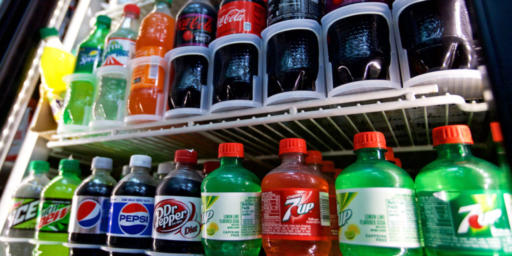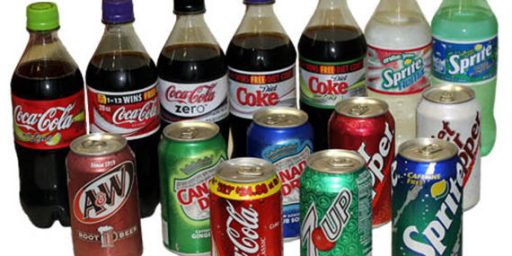Soda Sales to Schools to End
The healthnik busybodies have pressured distributors to stop selling sugary drinks to schools.
The nation’s largest beverage distributors have agreed to halt nearly all soda sales to public schools, according to a deal announced Wednesday by the William J. Clinton Foundation. Under the agreement, the companies have agreed to sell only water, unsweetened juice and low-fat milks to elementary and middle schools, said Jay Carson, a spokesman for former President Bill Clinton. Diet sodas would be sold only to high schools.
[…]
The deal follows a wave of regulation by school districts and state legislatures to cut back on student consumption of soda amid reports of rising childhood obesity rates. Soda has been a particular target of those fighting obesity because of its caloric content and popularity among children.
I don’t recall having soda machines available when I was in school but, certainly, sodas were available. Whole milk, known then as “milk,” was routinely included with school lunches. Most of us were well within healthy weight parameters.
The reason our kids are so fat is not that they drink too many soft drinks. A can of Coca-Cola has 140 calories and its leading competitor 150. Unless the kid is having ten of those a day, that’s negligible. The lack of exercise and poor dietary choices are almost certainly the reason for the explosion in childhood obesity.
Ironically, the industry is going to get great press for going along with this deal “for the children” despite this fact:
Under the agreement, high schools will still be able to purchase drinks such as diet and unsweetened teas, diet sodas, sports drinks, flavored water, seltzer and low-calorie sports drinks from distributors. School sales of those kinds of drinks have been on the rise in recent years, while regular soda purchases by students have been falling, according to an ABA report released in December. But regular soda is still the most popular drink among students, accounting for 45 percent of beverages sold in schools in 2005, the report said.
And, by the way, a bottle of Diet Snapple is certainly more profitable than a can of Coke.






I agree the problem isn’t soda, it is more that kids aren’t as active. When I was a kid, once I got home from school and finished any homework, I was outside, on my bike, running around and playing until dinner time, and often back outside for some more play, depending on whether it was dark yet. I remember, when I was 10 my best friend and I would ride our bikes (about 2 miles one way) to the pool to swim just about every day of the summer.
Kids now do too much sitting, they watch too much TV, play too many video games (and I am often shocked by just how much time 7 year olds spend playing video games), and not enough time outside. I think part of the problem is that parents are on the over protective side, and I admit to being part of this group (I probably wouldn’t let my 10 year old run around town, the way I did as a 10 year old), but I do limit the amount of TV and video game time for my kids.
Also, I am far more bothered by the content of the actual foods, than whether soda is available. Our school quite often serves poptarts for breakfast-hardly a low in fat, low in sugar, low in preservatives food.
Its not a panacea, but its a step in the right direction.
It’s not obvious to me that’s true. Got a citation?
In my state it was mandated.
Whole milk is also more likely to give a feeling of satiety than skim. Frankly, I think a lot of the reason for the fattening of America (besides lack of exercise and demographics) is bad dietary advice from professionals.
Dave,
No citation, just common sense. Both are incredibly cheap to make and Snapple sells for a whole lot more per unit and has less marketing overhead.
I’d think that the ingredients for Snapple were a bit more expensive and that would eat into the margins a bit.
You may well be right. I’m just curious.
Dave: I Google’d around earlier and couldn’t find anything definitive. I just figure Snapple is a lot more expensive than Coke at the point of purchase and neither can cost much to make.
Yeah, me too. That’s why I asked.
While I completely agree that, in general, kids exercise too little, I think that sodas do contribute to poor health more than the 150 calories or so would suggest. As I understand it, high fructose corn syrup is extremely difficult for the body to convert to anything useful, and thus pretty much gets converted directly to fat. When I was young, they still made sodas with sugar which is easier for the body to process into energy (corn syrup is cheaper, hence the change). At least this is some sort of change for the better.